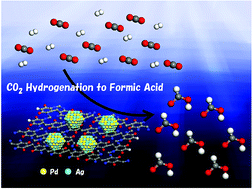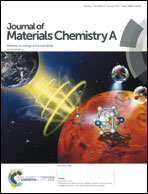PdAg nanoparticles supported on resorcinol-formaldehyde polymers containing amine groups: the promotional effect of phenylamine moieties on CO2 transformation to formic acid†
Abstract
The transformation of CO2 to formic acid (FA, HCOOH) is one of the most promising means of developing economically-viable CO2-mediated energy cycles, owing to the many advantages of FA as a feedstock, hydrogen source and fuel source for fuel cells. In the present study, we synthesized a series of catalysts consisting of PdAg nanoparticles supported on resorcinol-formaldehyde polymers having various amine contents (PdAg/amine-RF). These catalysts exhibited significant activity during CO2 hydrogenation to produce FA, especially when the support with the highest amine concentration was employed. Analyses of active Pd species using X-ray absorption fine structure (XAFS) and X-ray photoelectron spectroscopy (XPS) demonstrated the formation of Pd–N bonds in these materials, and oxidized nitrogen, phenylmethanimine, phenylimine and phenylamine moieties were identified based on N 1s XPS data. Density functional theory calculations showed that the adsorption energy of bicarbonate ions on the PdAg alloy is much higher in close proximity to phenylamine molecules, while the activation energy of the rate determining step is significantly lower. These predictions are in good agreement with the experimental results, which demonstrate that the reaction order associated with the bicarbonate concentration is decreased with increasing nitrogen concentration in the catalyst. A significant correlation was observed between the turnover number and the nitrogen content (attributed to the presence of phenylamine moieties) estimated from both XPS and elemental analysis, indicating that phenylamine groups made the most significant contribution toward the promotion of this reaction.



 Please wait while we load your content...
Please wait while we load your content...